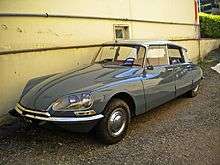André Lefèbvre
André Lefebvre (19 August 1894 – 4 May 1964) was a French automobile engineer.
André René Lefebvre was born in Louvres, France (North of Paris, Val d'Oise). He began his career as an aviation engineer working for Voisin. He was also a racing driver and race car designer, and won the 1927 Rallye Monte Carlo.
He joined the auto-industry in 1931, working for Louis Renault. Renault was persuaded to recruit Lefèbvre by François Lehideux, himself a senior executive within the company (who was also married to the daughter of Renault's brother).[1]
Lefebvre remained with Renault only until 1933, when he was hired by André Citroën for his automobile factory. After the death of André Citroën in 1935, Lefèbvre continued his work at Citroën, now led by the innovative entrepreneur Pierre-Jules Boulanger, who came to the company from Michelin.

Working with Citroën designers Flaminio Bertoni and Paul Magès, Lefèbvre created four of the most dramatic, boldly designed vehicles of 20th century:
- Citroën Traction Avant (1934-1957) – a large family sedan, a favourite of gangsters, the French resistance and the Gestapo, built for 23 years
- Citroën 2CV (1948-1990) – a small, advanced, utilitarian sedan, known as "the duck" or "Tin Snail", built for 42 years
- Citroën DS (1955-1975) – a radically advanced, large family sedan, seen as shark like, built for 20 years
- Citroën HY (1947-1981) – a corrugated, practical delivery van, built for 34 years
The 1955 Citroën DS placed third in the 1999 Car of the Century competition, behind the Ford Model T and BMC Mini.
Sources and further reading
- ↑ Gijsbert-Paul Berk, Andre Lefebvre and the Cars He Created at Voisin and Citroen, Veloce Publishing Ltd, 2009, pp. 54-55